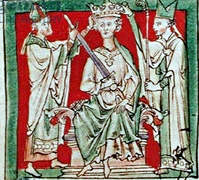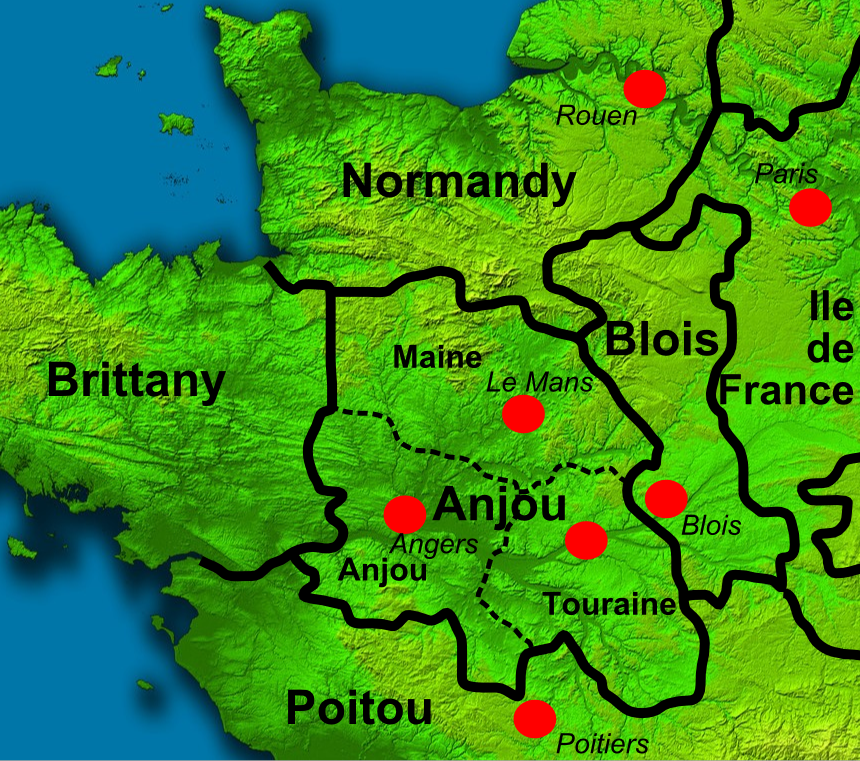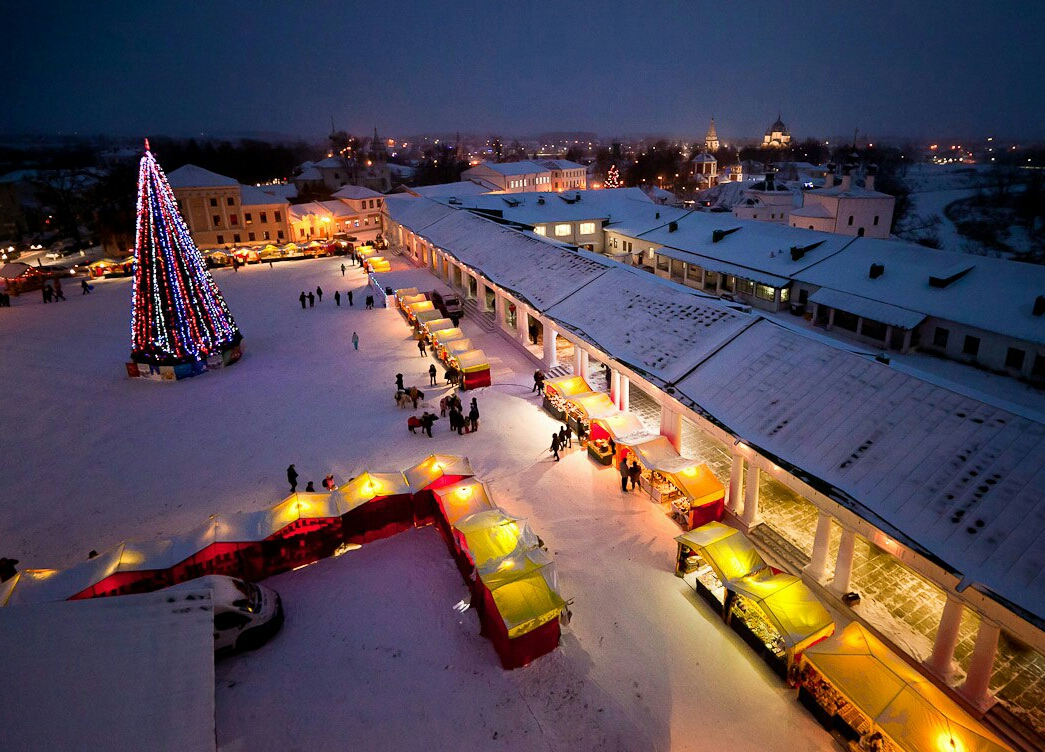|
1155 Deaths
Year 1155 ( MCLV) was a common year starting on Saturday of the Julian calendar. Events By place Europe * April 18 – Siege of Tortona: German forces capture the citadel of Tortona (after a two-month siege). The city is razed to the ground, including the graves. * June 18 – King Frederick I (Barbarossa) is crowned as Emperor of the Holy Roman Empire by Pope Adrian IV at St. Peter's Basilica in Rome. * Arnold of Brescia is exiled by Adrian IV and forced to flee. He is arrested by imperial forces, hanged, and his body burned at the stake in Rome in June. * The city of Bari rebels against King William I (the Bad) of Sicily and recognizes the Byzantine emperor, Manuel I (Komnenos), as its overlord. * The Virgin of Vladimir (or Our Lady of Vladimir) is taken by Grand Prince Andrey Bogolyubsky to Vladimir from Suzdal. England * Spring – King Henry II has the Palace of Westminster (which is badly damaged by Stephen's supporters during The Anarchy) repai ... [...More Info...] [...Related Items...] OR: [Wikipedia] [Google] [Baidu] |
William I Of Sicily
William I (1120 or 1121 7 May 1166), called the Bad or the Wicked (), was the second king of Sicily, ruling from his father's death in 1154 to his own in 1166. He was the fourth son of Roger II and Elvira of Castile. William's title "the Bad" seems little merited and expresses the bias of the historian Hugo Falcandus and the baronial class against the king and the official class by whom he was guided. Early life William was the son of King Roger II of Sicily, grandson of Count Roger I of Sicily, and great-grandson of Tancred of Hauteville. He grew up with little expectation of ruling. The deaths of his three older brothers Roger, Tancred, and Alfonso between 1138 and 1148 changed matters, though when his father died William was still not well-prepared to take his place. Kingship On assuming power, William kept the administration which had guided his father's rule for his final years. Only the Englishman Thomas Brun was removed, and the chancellor Maio of Bari was promo ... [...More Info...] [...Related Items...] OR: [Wikipedia] [Google] [Baidu] |
Bridgnorth Castle
Bridgnorth Castle is a castle in the town of Bridgnorth, Shropshire. It is a scheduled monument, first listed in 1928. History 11th century The castle was founded in 1101 by Robert de Belleme, the son of the French Earl, Roger de Montgomerie, 1st Earl of Shrewsbury, Roger de Montgomery, who succeeded his father as Earl of Shrewsbury, possibly on the site of a Saxon burh built by Æthelflæd in 912. One year later in 1102, King Henry I of England, Henry I took control of the castle from Robert de Belleme and Henry built another temporary castle on Panpudding Hill. Much of the outer building, which consists of shattered walls, dates to a period of construction that is believed to have occurred between 1105-1113. Around 1120, Henry I re-plastered the walls of the castle and replaced them with better quality stone. Its principal feature, a square great tower, was built during the reign of Henry II of England, Henry II in 1160 and the castle was extended between 1166-1174. In the ear ... [...More Info...] [...Related Items...] OR: [Wikipedia] [Google] [Baidu] |
Diocese Of Canterbury
The Diocese of Canterbury is a Church of England diocese covering East Kent, eastern Kent which was founded by St Augustine of Canterbury in 597. The diocese is centred on Canterbury Cathedral and is the oldest episcopal see, see of the Church of England. Bishops The diocesan bishop is the archbishop of Canterbury. However, because of their roles as metropolitan bishop of the Province of Canterbury, Primate of All England and "first bishop" of the worldwide Anglican Communion, the archbishop (whose primary residence is at Lambeth Palace in London) is often away from the diocese. Therefore, their suffragan bishop, the bishop of Dover (presently Rose Hudson-Wilkin), is in many ways empowered to act almost as if she were the diocesan bishop. The diocese had from 1944 to 2009 a second locally focussed suffragan bishop, the bishop of Maidstone (this version of the post was discontinued in November 2010), who had a similar though subordinate role to that of the Bishop of Dover. Tw ... [...More Info...] [...Related Items...] OR: [Wikipedia] [Google] [Baidu] |
Thomas Becket
Thomas Becket (), also known as Saint Thomas of Canterbury, Thomas of London and later Thomas à Becket (21 December 1119 or 1120 – 29 December 1170), served as Lord Chancellor from 1155 to 1162, and then as Archbishop of Canterbury from 1162 until his death in 1170. He engaged in conflict with Henry II, King of England, over the rights and privileges of the Church and was murdered by followers of the King in Canterbury Cathedral. Soon after his death, he was canonised by Pope Alexander III. He is venerated as a saint and martyr by the Catholic Church and the Anglican Communion. Sources The main sources for the life of Becket are a number of biographies written by contemporaries. A few of these documents are by unknown writers, although traditional historiography has given them names. The known biographers are John of Salisbury, Edward Grim, Benedict of Peterborough, William of Canterbury, William fitzStephen, Guernes of Pont-Sainte-Maxence, Robert of Cricklade, ... [...More Info...] [...Related Items...] OR: [Wikipedia] [Google] [Baidu] |
The Anarchy
The Anarchy was a civil war in England and Duchy of Normandy, Normandy between 1138 and 1153, which resulted in a widespread breakdown in law and order. The conflict was a war of succession precipitated by the accidental death of William Adelin (the only legitimate son of Henry I of England, Henry I), who drowned in the White Ship disaster, ''White Ship'' disaster of 1120. Henry sought to be succeeded by his daughter, known as Empress Matilda, but was only partially successful in convincing the nobility to support her. On Henry's death in 1135, his nephew Stephen of Blois seized the throne with the help of Stephen's brother Henry of Blois, who was the bishop of Winchester. He was crowned as Stephen, King of England, King Stephen, and his early reign saw fierce fighting with disloyal English barons, rebellious Welsh leaders, and Scottish invaders. Following a major rebellion in the southwest of England, Matilda invaded in 1139 with the help of her half-brother Robert, 1st Earl o ... [...More Info...] [...Related Items...] OR: [Wikipedia] [Google] [Baidu] |
Stephen, King Of England
Stephen (1092 or 1096 – 25 October 1154), often referred to as Stephen of Blois, was King of England from 22 December 1135 to his death in 1154. He was Count of Boulogne ''jure uxoris'' from 1125 until 1147 and Duke of Normandy from 1135 until 1144. His reign was marked by the Anarchy, a civil war with his cousin and rival, the Empress Matilda, whose son, Henry II, succeeded Stephen as the first of the Angevin kings of England. Stephen was born in the County of Blois in central France as the fourth son of Stephen-Henry, Count of Blois, and Adela, daughter of William the Conqueror. His father died as a crusader while Stephen was still young, and he was brought up by his mother. Placed into the court of his uncle Henry I of England, Stephen rose in prominence and was granted extensive lands. He married Matilda of Boulogne, inheriting additional estates in Kent and Boulogne that made the couple one of the wealthiest in England. Stephen narrowly escaped drowning with ... [...More Info...] [...Related Items...] OR: [Wikipedia] [Google] [Baidu] |
Palace Of Westminster
The Palace of Westminster is the meeting place of the Parliament of the United Kingdom and is located in London, England. It is commonly called the Houses of Parliament after the House of Commons and the House of Lords, the two legislative chambers which occupy the building. The palace is one of the centres of political life in the United Kingdom; "Westminster" has become a metonym for the UK Parliament and the British Government, and the Westminster system of government commemorates the name of the palace. The Elizabeth Tower of the palace, nicknamed Big Ben, is a landmark of London and the United Kingdom in general. The palace has been a Grade I listed building since 1970 and part of a UNESCO World Heritage Site since 1987. The building was originally constructed in the eleventh century as a royal palace and was the primary residence of the kings of England until 1512, when a fire destroyed the royal apartments. The monarch moved to the adjacent Palace of Whitehall, bu ... [...More Info...] [...Related Items...] OR: [Wikipedia] [Google] [Baidu] |
Henry II Of England
Henry II () was King of England The monarchy of the United Kingdom, commonly referred to as the British monarchy, is the form of government used by the United Kingdom by which a hereditary monarch reigns as the head of state, with their powers Constitutional monarchy, regula ... from 1154 until his death in 1189. During his reign he controlled Kingdom of England, England, substantial parts of Wales in the High Middle Ages, Wales and Lordship of Ireland, Ireland, and much of Kingdom of France, France (including Duchy of Normandy, Normandy, County of Anjou, Anjou, and Duchy of Aquitaine, Aquitaine), an area that altogether was later called the Angevin Empire, and also held power over Kingdom of Scotland, Scotland and the Duchy of Brittany. Henry was the eldest son of Geoffrey Plantagenet, Count of Anjou, and Empress Matilda, Matilda, daughter of Henry I of England. By the age of fourteen, he became politically and militarily involved in The Anarchy, his mother's efforts ... [...More Info...] [...Related Items...] OR: [Wikipedia] [Google] [Baidu] |
Suzdal
Suzdal (, ) is a Types of inhabited localities in Russia, town that serves as the administrative center of Suzdalsky District in Vladimir Oblast, Russia, which is located along the Kamenka tributary of the Nerl (Klyazma), Nerl River, north of the city of Vladimir, Russia, Vladimir. As of the Russian Census (2021), 2021 Census, its population was 9,286. In the 12th century, Suzdal became the capital of the principality. Currently, Suzdal is the smallest of the Russian Golden Ring of Russia, Golden Ring towns. It has several sites listed as World Heritage Site, UNESCO World Heritage Sites. History The town's history dates back to 999 and 1024. In 1125 Yuri Dolgorukiy, Yury Dolgoruky made Suzdal the capital of the Vladimir-Suzdal#Rostov-Suzdal, Rostov-Suzdal principality. In 1157, Andrey Bogolyubsky, Andrei Bogolyubsky moved the capital from Suzdal to Vladimir, from which time the principality was known as Vladimir-Suzdal. Suzdal was burned and plundered in 1237 during the Mo ... [...More Info...] [...Related Items...] OR: [Wikipedia] [Google] [Baidu] |
Vladimir, Russia
Vladimir (, ) is a types of inhabited localities in Russia, city and the administrative center of Vladimir Oblast, Russia, located on the Klyazma River, east of Moscow. It is served by a railway and the M7 motorway (Russia), M7 motorway. Population: History Vladimir was Vladimir-Suzdal, one of the medieval capitals of Russia, with significant buildings surviving from the 12th century. Two of its Russian Orthodox cathedrals, a monastery, and associated buildings have been designated among the White Monuments of Vladimir and Suzdal, a UNESCO World Heritage Site. In the past, the city was also known as Vladimir-on-Klyazma () and Vladimir-Zalessky (), to distinguish it from Volodymyr, Volyn Oblast, another Vladimir/Volodymyr in Volhynia (modern-day Ukraine). Foundation The founding date of Vladimir is disputed between 990 and 1108. In the ''Novgorod First Chronicle'', Vladimir is mentioned under the year 1108, and during the Soviet period, this year was decreed to be its foundatio ... [...More Info...] [...Related Items...] OR: [Wikipedia] [Google] [Baidu] |
Andrey Bogolyubsky
Andrey Yuryevich Bogolyubsky (, lit. Andrey Yuryevich of Bogolyubovo; died 28 June 1174) was Prince of Vladimir-Suzdal from 1157 until his death. During repeated internecine wars between the princely clans, Andrey accompanied his father Yuri Dolgorukiy during a brief capture of Kiev in 1149. 20 years later, his son led the Sack of Kiev (1169). He was canonized as a saint in the Russian Orthodox Church in 1702. Biography According to the ''Primary Chronicle'' (PVL), Andrey's parents married on 12 January 1108, as part of a peace agreement between the Rus' and the Cumans (Polovtsi). Andrey's father was Yuri Vladimirovich (), Prince of Rostov and Suzdal commonly known as Yuri Dolgoruki (), a son of Volodimer II Monomakh, progenitor of the Monomakhovichi. Andrey's mother was an unnamed Cuman princess, a daughter of Aepa son of Osen'. From this marriage, Andrey Bogolyubsky was born in 1111. Yuri proclaimed Andrey a prince in Vyshgorod (near Kiev). Seizing power (1155– ... [...More Info...] [...Related Items...] OR: [Wikipedia] [Google] [Baidu] |








